
The Order of Friars Minor Capuchin is a religious order of Franciscan friars within the Catholic Church, one of three "First Orders" that reformed from the Franciscan Friars Minor Observant, the other being the Conventuals (OFMConv). Franciscans reformed as Capuchins in 1525 with the purpose of regaining the original Habit (tunic) of St. Francis of Assisi and also for returning to a stricter observance of the rule established by Francis of Assisi in 1209.

Pio of Pietrelcina, widely known as Padre Pio, was an Italian Capuchin friar, priest, stigmatist, and mystic. He is venerated as a saint in the Catholic Church, celebrated on 23 September.

The Sanctuary of Saint Pio of Pietrelcina, also called Shrine of Padre Pio or Padre Pio Pilgrimage Church, is a Catholic shrine in San Giovanni Rotondo, Province of Foggia, Italy, owned by the Order of Friars Minor Capuchin and dedicated to the Italian Capuchin friar, priest, stigmatist, and mystic, widely known as Padre Pio.

Leopold Mandić [Mandich], OFMCap was a Croatian Capuchin friar and Catholic priest, who suffered from disabilities that would plague his speech and stature. He developed tremendous spiritual strength in spite of his disabilities and became extremely popular in his ministry as a confessor, often spending 12–15 hours in the confessional.
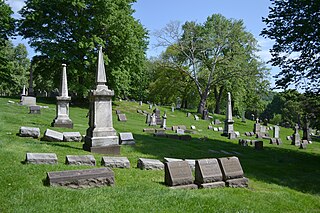
Saint Mary Cemetery is a Roman Catholic burial ground located at 45th and Penn Avenues in the Central Lawrenceville neighborhood of Pittsburgh, Pennsylvania, US. It is adjacent of the city's slightly older and much larger Allegheny Cemetery. A chain-link fence separates the two cemeteries.

St. Stanislaus Kostka Church in Pittsburgh, Pennsylvania, referred to in Polish as Kościół Świętego Stanisława Kostki, is a historic church of the Roman Catholic Diocese of Pittsburgh. Located in the Strip District in Pittsburgh, Pennsylvania, United States, it is a prime example of the so-called 'Polish Cathedral' style of churches. It is known also as 21st and Smallman Street Church. It is listed on the U.S. National Register of Historic Places.
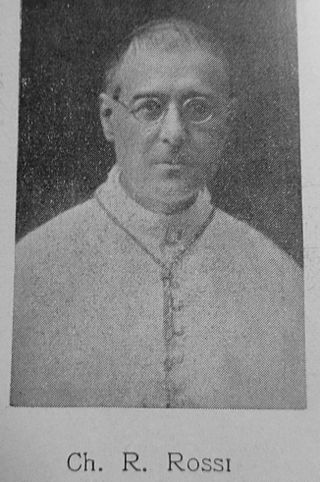
Raffaele Rossi, OCD, born Carlo Rossi,, was an Italian Discalced Carmelite and cardinal. Rossi served in the Sacred Consistorial Congregation in the Roman Curia from 1930 until his death and as a friar had the religious name "Raffaele of Saint Joseph". Pope Pius XI elevated him into the cardinalate in 1930. His cause of beatification began three decades after his death and he is known as a Servant of God.

St. Cecilia Church is a Roman Catholic parish church in the Roman Catholic Archdiocese of New York and a historic landmark located at 120 East 106th Street between Park Avenue and Lexington Avenue, Manhattan, New York City, New York. The parish was established in 1873. It was staffed by the Redemptorist Fathers from 1939 to 2007. The church was designated a New York City landmark in 1976. The church and convent were listed on the U.S. National Register of Historic Places in 1984.

Calvary Episcopal Church is a parish of the Episcopal Diocese of Pittsburgh, Pennsylvania. The parish was founded in 1855.
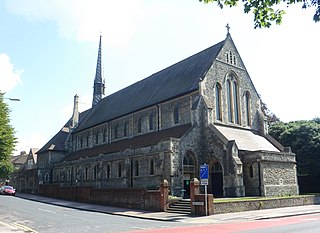
St John the Evangelist's Church is an Anglican church in the Preston Village area of Brighton, in the English city of Brighton and Hove. The Grade II listed building, designed by Sir Arthur Blomfield, was started in 1901 but did not take its present form for another quarter of a century. In the meantime, the nearby parish church of Preston was severely damaged by fire, and the new church was granted the parish church status which it still retains.

John Theodore Comès was a Pittsburgh-based architect best remembered for his many buildings for Roman Catholic communities throughout the United States.
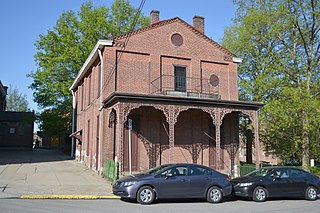
The Saint Mary's Academy Building is a historic building in the Lawrenceville neighborhood of Pittsburgh, Pennsylvania. Built in 1854, it is a notable example of Greek Revival architecture and one of the neighborhood's only surviving buildings dating to the pre–Civil War era. It was the first structure built by St. Mary's parish, the first Catholic parish in Lawrenceville, and was originally used as both a church and school. In 1874, a new St. Mary's Church was built next door. St. Mary's merged with three other Lawrenceville parishes in 1993 to form the new Our Lady of Angels parish. The St. Mary church buildings remained in use for a few years but closed in 2004.
St. Peter Church, is a Catholic parish church in Cleveland, Ohio and part of the Diocese of Cleveland. Founded in 1853, it is located at the intersection of Superior Ave. near East 17th St., in the Downtown neighborhood.
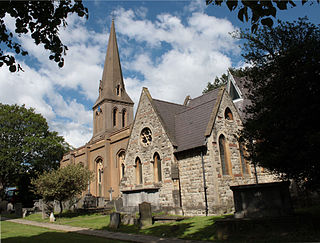
St Leonard's Church is a Church of England parish church in the London Borough of Lambeth. It is a Grade II listed building and occupies a prominent position on the west side of Streatham High Road, at its junction with Tooting Bec Gardens and Mitcham Lane.

The Parish and National Shrine of Saint Padre Pio, commonly known as Padre Pio Shrine, is a Roman Catholic parish church and pilgrimage site situated along Governor Antonio Carpio Avenue in Barangay San Pedro, Santo Tomas, Batangas, Philippines. It is consecrated to the Italian Saint Pio of Pietrelcina.

St. Mary's Church is an historic, former American Catholic church that is located in the Lawrenceville neighborhood of Pittsburgh, Pennsylvania.

The Former Pittsburgh Wash House and Public Baths Building is located at 3495 Butler Street in the Lawrenceville neighborhood of Pittsburgh, Pennsylvania. Built in 1904 in the Romanesque Revival architectural style, the building today serves as office space. The bath house was designated a Pittsburgh historic landmark in 2018 and was listed as a contributing property in the Lawrenceville Historic District in 2019.

Holy Family Church is a historic former Roman Catholic church in the Lawrenceville neighborhood of Pittsburgh, Pennsylvania, and a contributing property in the Lawrenceville Historic District. The church was built in 1939–40 and was designed in the Romanesque Revival architectural style with modernist design principles.

St. Agnes Church is a historic former Roman Catholic church in the West Oakland neighborhood of Pittsburgh, Pennsylvania. The church was built in 1916–17 and was designed by noted Pittsburgh-based ecclesiastical architect John T. Comès. St. Agnes parish was established in 1868 and a temporary church opened in 1873 at 2400 Fifth Avenue in Uptown. This was replaced with a permanent church in 1889, but the building burned down along with several neighboring structures on January 21, 1914. Following the fire, the present church was built about 0.3 miles (0.48 km) to the east of the old location. The new building was dedicated by Bishop Regis Canevin on January 28, 1917.




















